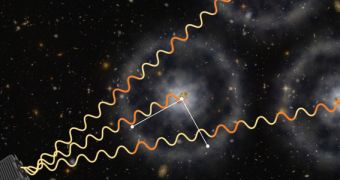Astronomers with the third Sloan Digital Sky Survey's (SDSS-III) Baryon Oscillation Spectroscopic Survey (BOSS) announce the development of the most precise chart revealing how the Universe expanded from its earliest days onwards. The dataset covers a time frame that begins with the emergence of the earliest galaxies.
BOSS is the most complex and important component of SDSS-III. The former has been studying the night sky for several years, using objects known as quasi-stellar radio sources, or quasars, to map the density variations that exist in intergalactic gas at extreme redshifts. This enables experts to reconstruct the early history of the Universe, down to the point where the first galaxies developed.
Quasars are the compact regions at the core of extremely distant active galactic nuclei (AGN). This region always surrounds a supermassive black hole of epic proportions, and spans an area around 10 to 10,000 times larger than the Schwarzschild radius around that black hole. This radius is denoted by the distance from a massive object below which not even light can escape that object's gravitational pull/
The reason why BOSS focuses on quasars for its studies is that astrophysicists believe these objects to be capable of revealing more information about dark energy, the mysterious type of energy believed to account for nearly three quarters of the Universe's mass-energy budget. Around 23 percent of this budget is accounted for by dark matter, and just 4 percent by regular matter.
This latest scientific effort from the BOSS Collaboration consisted of two scientific papers. The first was published by US Department of Energy’s (DOE) Lawrence Berkeley National Laboratory (Berkeley Lab) physicist Andreu Font-Ribera and his team in late 2013. The second appears this month, and is by expert Timothée Delubac, from the EPFL and the Centre de Saclay, in France.
Taken together, the two papers indicate that the Universe expands at a rate of around 68 kilometers (42 miles) per second per 1 million light-years, at a redshift of 2.34. The level of accuracy associated with this estimate is just 2.2 percent, the lowest ever achieved. Redshift is a value that measures how much light emitted in the optical or ultraviolet spectrum, for example, shifts towards infrared over time.
“This means if we look back to the Universe when it was less than a quarter of its present age, we’d see that a pair of galaxies separated by a million light years would be drifting apart at a velocity of 68 kilometers a second as the Universe expands. The uncertainty is plus or minus only a kilometer and a half per second,” Font-Ribera said.
The expert, who holds an appointment as a postdoctoral fellow with the Berkeley Lab Physics Division, presented the new findings at the April 2014 meeting of the American Physical Society, in Savannah, Georgia.
“Three years ago BOSS used 14,000 quasars to demonstrate we could make the biggest 3D maps of the Universe. Two years ago, with 48,000 quasars, we first detected baryon acoustic oscillations [BAO] in these maps. Now, with more than 150,000 quasars, we’ve made extremely precise measures of BAO,” concluded the lead investigator of BOSS, Berkeley Lab physicist David Schlegel.

 14 DAY TRIAL //
14 DAY TRIAL //